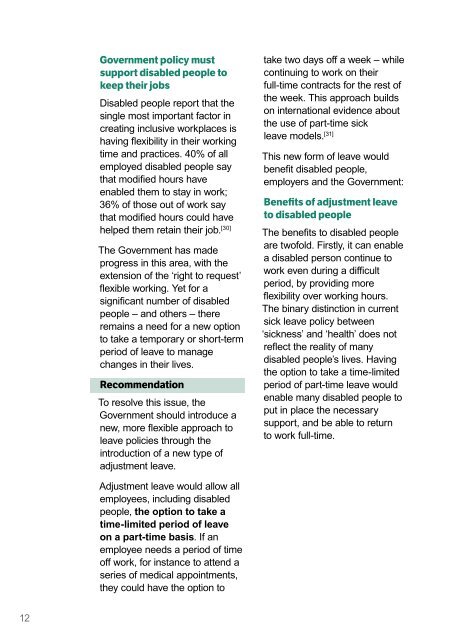A-million-futures-halving-the-disability-employment-gap.pdf?ext=
A-million-futures-halving-the-disability-employment-gap.pdf?ext=
A-million-futures-halving-the-disability-employment-gap.pdf?ext=
Create successful ePaper yourself
Turn your PDF publications into a flip-book with our unique Google optimized e-Paper software.
Government policy mustsupport disabled people tokeep <strong>the</strong>ir jobsDisabled people report that <strong>the</strong>single most important factor increating inclusive workplaces ishaving flexibility in <strong>the</strong>ir workingtime and practices. 40% of allemployed disabled people saythat modified hours haveenabled <strong>the</strong>m to stay in work;36% of those out of work saythat modified hours could havehelped <strong>the</strong>m retain <strong>the</strong>ir job. [30]The Government has madeprogress in this area, with <strong>the</strong>extension of <strong>the</strong> ‘right to request’flexible working. Yet for asignificant number of disabledpeople – and o<strong>the</strong>rs – <strong>the</strong>reremains a need for a new optionto take a temporary or short-termperiod of leave to managechanges in <strong>the</strong>ir lives.RecommendationTo resolve this issue, <strong>the</strong>Government should introduce anew, more flexible approach toleave policies through <strong>the</strong>introduction of a new type ofadjustment leave.Adjustment leave would allow allemployees, including disabledpeople, <strong>the</strong> option to take atime-limited period of leaveon a part-time basis. If anemployee needs a period of timeoff work, for instance to attend aseries of medical appointments,<strong>the</strong>y could have <strong>the</strong> option totake two days off a week – whilecontinuing to work on <strong>the</strong>irfull-time contracts for <strong>the</strong> rest of<strong>the</strong> week. This approach buildson international evidence about<strong>the</strong> use of part-time sickleave models. [31]This new form of leave wouldbenefit disabled people,employers and <strong>the</strong> Government:Benefits of adjustment leaveto disabled peopleThe benefits to disabled peopleare twofold. Firstly, it can enablea disabled person continue towork even during a difficultperiod, by providing moreflexibility over working hours.The binary distinction in currentsick leave policy between‘sickness’ and ‘health’ does notreflect <strong>the</strong> reality of manydisabled people’s lives. Having<strong>the</strong> option to take a time-limitedperiod of part-time leave wouldenable many disabled people toput in place <strong>the</strong> necessarysupport, and be able to returnto work full-time.“Any time off I take is nowvery closely monitored andI constantly have to justifymyself. The onus is verymuch on me to find a solutionand I am facing a lot ofpressure to reduce hours as ameans of managing flare ups.Of course, this means thatduring periods when <strong>the</strong> painis not as bad, I am underemployed. This makes me feeluseless and undervalued.”Jamie, Dunbar [32]Secondly, as Macmillan andDemos have pointed out, similarleave models can act as a formof financial protection fordisabled people. [33] During aperiod on full-time sick leavedisabled people experience asubstantial drop in income. Apart-time sick leave model wouldalleviate this because <strong>the</strong>employee retains part of <strong>the</strong>irfull-time earnings. Part-time sickleave can also reduce <strong>the</strong>likelihood of moving ontoun<strong>employment</strong> benefits – whichalso has a major impact onincome. [34]Benefits of adjustment leaveto employersAdjustment leave can saveemployers money. Internationalevidence shows that adjustmentleave models can lead tosignificant reductions in <strong>the</strong>number of people falling out ofwork. In Finland, a RandomisedControl Trial found thatcompared to full-time sick leave,a part-time model [35] :•Reduced<strong>the</strong> average length oftime off work from 20 days to12 days;•Reduced•Reducedtotal sickness absenceby 20%;<strong>the</strong> risk of someonemoving onto ‘<strong>disability</strong> pension’(roughly equivalent toEmployment and SupportAllowance) by 6%.With enough flexibility in <strong>the</strong>policy, this will reduce costs foremployers by allowing <strong>the</strong>m toretain productivity compared tohaving a staff member on sickleave, retain employees’networks and experience, andreduce <strong>the</strong> number of staffmoving onto full time sick leave.Adjustment leave should be oneof many possible adjustmentsthat could be made for adisabled person to stay in work– which is why <strong>the</strong> model shouldbe time-limited. For a disabledperson with an on-going needfor periods of time off, a standardpart-time or o<strong>the</strong>r flexibleworking model may be moreappropriate – and morecost-neutral for an employer.However, <strong>the</strong>re is a clear needfor a new way for employees tomanage a temporary change in<strong>the</strong>ir situation.12 13


